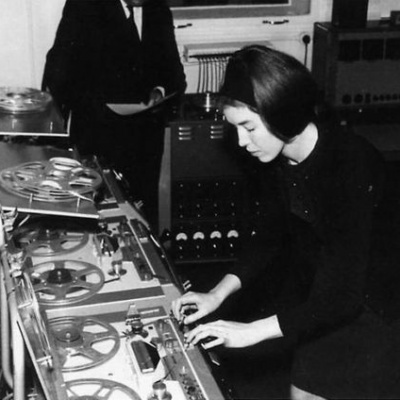
White Noise
by Christopher Evans By the time White Noise's debut album, An Electric Storm, arrived in 1969, the Moog synthesizer had already started to make tentative appearances on pop records by the likes of the Monkees and Simon & Garfunkel. More primitive tone generators had also provided spacy effects for bands like the United States of America. But no other pop or rock record before (or since) had been so painstakingly assembled using mainly homemade equipment and tape recorders. The White Noise project had its origins in the BBC's Radiophonic Workshop, whose previous claim to worldwide fame was the theme music to Doctor Who. The workshop was peopled by a small team of technical wizards and musicians whose principal function was to generate futuristic effects and music for BBC TV and radio programs. Among them was Delia Derbyshire, frequently championed by future generations as a pioneer of British techno. Derbyshire, Peter Zinovieff, and Brian Hodgson were also members of a group called Unit Delta Plus, formed in 1966 to promote the composition and performance of electronic music, and it was one of their lectures that inspired an American named David Vorhaus to start writing his own electronic music. The son of a blacklisted film director, Vorhaus had come to the U.K. to avoid the draft and earn an electronics degree, while also studying classical music and playing the double bass.Vorhaus persuaded Derbyshire and Hodgson to collaborate on a more pop-oriented project with him while maintaining their day jobs at the BBC. With two tracks in the can, recorded on a six-Revox setup synchronized by a single remote control, Vorhaus was introduced to Island Records' Chris Blackwell, who was so impressed that he commissioned a whole album. The team had been hoping to make a killing by selling the two tracks as a single, but Blackwell's advance of £3,000 prompted them to reconsider. They set about building their own studio-cum-science lab in Camden Town out of "borrowed" gear and improvised equipment. A number of friends were brought in to provide drums, lyrics, and vocals, but most of the team's time was expended on realizing the backing tracks. With no keyboard-based polyphonic synthesizers available to them, every last chord had to be assembled from numerous tape edits painstakingly stuck together. Much use was made of musique concrète techniques, whereby physically generated sounds would be subjected to all manner of electronic distortion and tape manipulation. Vorhaus later ventured his opinion that An Electric Storm contained more edits than any other album in the history of recording.The process had already lasted a year when Island -- with Blackwell having departed -- began to feel a little twitchy about their investment. Though at that point the album's second side was still only 11 minutes long, they demanded that Vorhaus finish it pronto. Having heard Pink Floyd's recently released A Saucerful of Secrets, a lengthy instrumental track on which a drum riff underpins a cacophony of noise, Vorhaus realized he might get away with something similar to finish his album. The result was the hair-raising -- if faintly risible -- "Black Mass: An Electric Storm in Hell," which replaces Saucerful's heavenly choir with the sound of souls screaming in eternal torment. Inevitably, there was no way Vorhaus and his team could reproduce the album live, and with a similar vacuum on the interview front the album initially sold poorly. Yet through word of mouth it acquired a reputation that kept it selling in modest quantities throughout the '70s and beyond. Quite simply, it's an album that sounds like no other.By 1970, however, White Noise had been overtaken by events. As the Moog synthesizer became widely available, the kind of equipment used by the Radiophonic Workshop team became obsolete almost overnight. And since it was this very equipment that gave the White Noise album so much of its charm, there was never any question of a full-scale follow-up. However, several years later Vorhaus attempted to revive the White Noise name with a solo instrumental album for Virgin performed entirely on the Moog and called, somewhat portentously, White Noise 2: Concerto for Synthesizer. By then, though, the market was already flooded with synth albums and the record made little impact. A third album called Re-Entry for the Pulse label in 1980 met a similar fate, as did Sound Mind (2000) and Inferno (2001).
